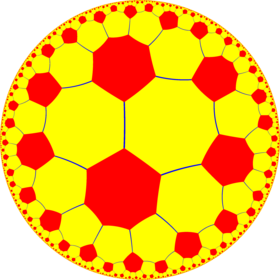| Truncated order-7 square tiling | |
|---|---|
 Poincaré disk model of the hyperbolic plane | |
| Type | Hyperbolic uniform tiling |
| Vertex configuration | 8.8.7 |
| Schläfli symbol | t{4,7} |
| Wythoff symbol | 2 7 | 4 |
| Coxeter diagram | |
| Symmetry group | [7,4], (*742) |
| Dual | Order-4 heptakis heptagonal tiling |
| Properties | Vertex-transitive |
In geometry, the truncated order-7 square tiling is a uniform tiling of the hyperbolic plane. It has Schläfli symbol of t0,1{4,7}.
YouTube Encyclopedic
-
1/5Views:134 13012 3241 0292 861884
-
15 bumfit - Numberphile
-
Mod-01 Lec-06 Geometry of Crystals: Symmetry, Lattices
-
8. Quasi-Newton-Raphson Methods
-
Lecture 6: Architectural Origami
-
Atlantean Daily Life (1/14): Housing (a lecture by: Jonathan Barlow Gee)
Transcription
ROGER BOWLEY: I want to talk about the number 15 in English, but it's not English that you know. This is going to be Celtic English, before the Romans came here. So it's not going to be English that comes from German, like ein, zwei, drei, 1, 2, 3. This is the form of English used by shepherds to count their flocks. And I've spent quite a lot of time, Brady, learning how to say yan, tan, tethera, pethera, pimp for 1, 2, 3, 4, 5. TICH RIVETT: Well, there's yan, tan, tethera, pethera, pimp. ROGER BOWLEY: Pimp is five. I find that quite nicely amusing. And then, it's cethera, lethera, hoverer, coverer, dik. And then you get onto the next numbers, which are yanadik, because it's 1 and 10. Yanadik, tanadik, tetheradik, petheradik, and then it's bumfit. So 15 is bumfit. And if you want to take anything away from this, it is a pimp plus a dik is a bumfit. And then you get yanabumfit, tanabumfit, tetherabumfit, petherabumfit, figgit. TICH RIVETT: Tetheradik, bumfit. Cetherabumfit, letherabumfit, figgit. And hang on, I'm starting to get a notch in me stick. ROGER BOWLEY: Now, this changes depending on which part of the country. This is the Lincolnshire version. If you go down south, it's more refined. So it's yain, tain, tethera, pethera. So this is 5 sheep plus 10 sheep equals 15. All right, there's a little woolly thing with a head out here and a little toe. And he's coming along. All right, this is a pimp plus a dik. Oh, I can't even say it right. Dik is equal to a bumfit. In some part of the country, that has two T's, but that's not really relevant at all. So you have up to 20. So a pimp plus the dik plus another pimp is a figgit. They get to figgit, they get to 20 sheep, and they couldn't cope with that. I mean, that's hard enough to do, and it'll keep you awake. So if you're actually counting sheep this way, you'll keep awake rather than nodding off. And then they put a stone in their pocket. So at 20, they stop at 20, and they start counting again with a stone in their pocket or a marble. Or they might draw a line on the ground. And then they would go, the same thing again for the next 20. So this is a base 20 system, which is not very good because you have to rely on something else in order to count up to maybe 80 or 100. Because they want to take their sheep over somewhere else and flock them off on other numbers. And they want as many as possible. People keep it going, but there was a tradition until about 1900 where the farmers and the shepherds were still using this, so it became part of the culture written down. And so there's a record of this. Not a television record, but a record of it, so that people know about this system. And it's different in different parts of the country, including Scotland, including Wales. BRADY HARAN: What was it about these numbers that appealed to you? Are you a bit juvenile, or what is it? ROGER BOWLEY: Yeah, yeah. I find as I get older, I immature with age.
Related polyhedra and tiling
| *n42 symmetry mutation of truncated tilings: n.8.8 | |||||||||||
|---|---|---|---|---|---|---|---|---|---|---|---|
| Symmetry *n42 [n,4] |
Spherical | Euclidean | Compact hyperbolic | Paracompact | |||||||
| *242 [2,4] |
*342 [3,4] |
*442 [4,4] |
*542 [5,4] |
*642 [6,4] |
*742 [7,4] |
*842 [8,4]... |
*∞42 [∞,4] | ||||
| Truncated figures |

|

|

|

|

|

|

|

| |||
| Config. | 2.8.8 | 3.8.8 | 4.8.8 | 5.8.8 | 6.8.8 | 7.8.8 | 8.8.8 | ∞.8.8 | |||
| n-kis figures |

|

|

|

|

|

|

|

| |||
| Config. | V2.8.8 | V3.8.8 | V4.8.8 | V5.8.8 | V6.8.8 | V7.8.8 | V8.8.8 | V∞.8.8 | |||
| Uniform heptagonal/square tilings | |||||||||||
|---|---|---|---|---|---|---|---|---|---|---|---|
| Symmetry: [7,4], (*742) | [7,4]+, (742) | [7+,4], (7*2) | [7,4,1+], (*772) | ||||||||

|

|

|

|

|

|

|

|

|

| ||
| {7,4} | t{7,4} | r{7,4} | 2t{7,4}=t{4,7} | 2r{7,4}={4,7} | rr{7,4} | tr{7,4} | sr{7,4} | s{7,4} | h{4,7} | ||
| Uniform duals | |||||||||||

|

|

|

|

|

|

|

| ||||
| V74 | V4.14.14 | V4.7.4.7 | V7.8.8 | V47 | V4.4.7.4 | V4.8.14 | V3.3.4.3.7 | V3.3.7.3.7 | V77 | ||
References
- John H. Conway, Heidi Burgiel, Chaim Goodman-Strauss, The Symmetries of Things 2008, ISBN 978-1-56881-220-5 (Chapter 19, The Hyperbolic Archimedean Tessellations)
- "Chapter 10: Regular honeycombs in hyperbolic space". The Beauty of Geometry: Twelve Essays. Dover Publications. 1999. ISBN 0-486-40919-8. LCCN 99035678.
See also
External links
- Weisstein, Eric W. "Hyperbolic tiling". MathWorld.
- Weisstein, Eric W. "Poincaré hyperbolic disk". MathWorld.
- KaleidoTile 3: Educational software to create spherical, planar and hyperbolic tilings
- Hyperbolic Planar Tessellations, Don Hatch


